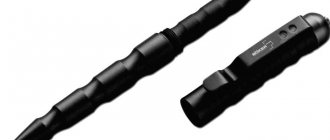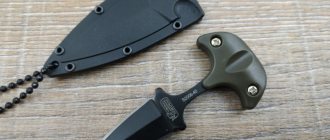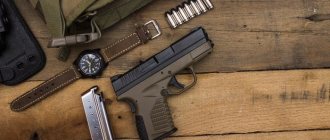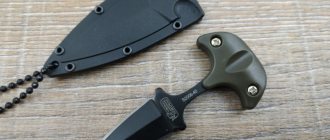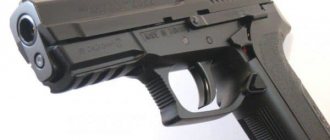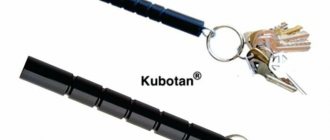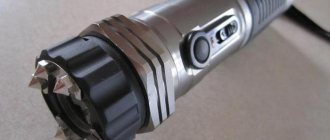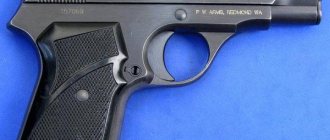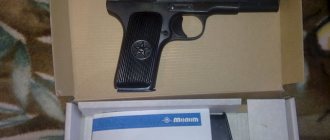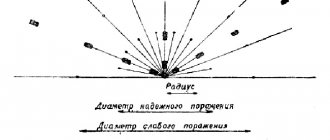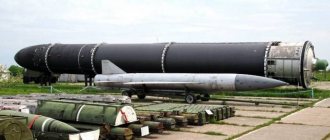It is not known exactly who came up with such a miniature self-defense weapon. Tactical pens have become widespread throughout the world due to two reasons: firstly, because of the unusual appearance of the product, and secondly, because of the good marketing campaign of tactical pen manufacturers, who constantly pointed out the versatility of this item.
Commercials show how this miniature object can easily neutralize even armed opponents. And the brutal appearance makes the product more attractive. But the real effectiveness of this means of self-defense remains in question. Let's consider where is truth and where is fiction.
History of occurrence and methods of application
The tactical self-defense pen was invented as a type of concealed weapon of the brass knuckle type. Essentially, these are yawara or kubotan disguised as office items. At the same time, a tactical pen is not recognized as a shock-crushing weapon (according to GOST-r 51215-98). Such an item can always be carried with you without raising questions from people around you, security guards or police officers.
The handle can be used for various purposes:
- a tactical ballpoint pen is suitable for taking notes (although it is not very convenient for this);
- as a stop or lever (titanium products are strong and reliable, so they can withstand significant weight);
- as a means of self-defense.
When used in self-defense, the technique of wielding a tactical pen is similar to the technique of wielding a combat knife.
There are three main grips:
- Straight grip. It's more suitable for a knife than a handle (it doesn't have a stop, so it can slip into your fist).
- Reverse grip. The most suitable method for fighting with a pen. You just need to hold your thumb on the rounded end of the object so that it does not slip out of your palm.
- A grip in which the end of the tactical pen rests against the palm and the shaft is held between the middle and ring fingers. It can only be used by experienced fighters.
A tactical pen is indeed useful as a means of self-defense, but it must be used wisely.
This is not a universal weapon, but a common item used for combat purposes.
The technique of working with a pen involves stabbing. There are two options here:
- deliver precise stabbing blows;
- carry out combinations of blows.
The main advantage of using a tactical pen in combat is its invisibility and the ability to deliver a surprise strike. It looks a little larger than ordinary pens, but is quite compact, which is why the ill-wisher does not have time to realize the real threat.
It is much more effective to make one effective and unexpected blow to neutralize the enemy when he is not ready to defend. A well-calibrated thrust with such an object will cause quite deep damage. You should hit the least protected pressure points:
- face (mainly nose and temple);
- neck;
- throat;
- collarbone;
- inner thighs;
- joints;
- floating ribs;
- armpit;
- spine.
Clothing can reduce the damage done, so you should hit uncovered areas of the body. Therefore, in cold periods, the use of a tactical pen is ineffective. However, in the midst of a fight, an ill-wisher will not simply allow himself to be hit in an unprotected point. Therefore, you can and should apply several blows with the pen.
In any case, the use of such weapons is only possible with extensive training and appropriate skills. Ideal if you also know Okinawan Kobudo or Aikido. You can practice strikes and check the behavior of the product on a thick board. After striking, the pen should remain in the clenched fist.
History of creation
Homemade weapon: Stinger Pen Gun
A stationery pen that also shoots appeared at the end of the 19th century. This is one of those cases where hidden weapons actually turned out to be quite effective. Such spy weapons were most often made illegally; factory-assembled copies are less common. Capable of causing serious damage to health, the shooting pen began to be used by agents of foreign intelligence services. In particular, there is a well-known case of a CIA sabotage operation in the 1940s, where a pen-gun played the role of a weapon.
Single-shot shooting pens were also made in Great Britain. The Scorpio model with a 5.6 mm barrel was popular. disposable. The batch numbers only 40 thousand copies and is now considered a rare collector's item.
Interesting Facts
This product, unlike a knife, is not prohibited from being carried and used, since, in fact, it is an ordinary pen. Plus, the handles in front of the knife are also safe for the owner. The knife is an offensive weapon. It is not so safe to use it for self-defense.
When choosing a tactical pen, you need to focus on the following features:
- Product strength. It is better if it is made of stainless steel or titanium: this model will withstand many impacts. A tactical pen can be made of hard wood (bamboo, etc.). Products made from aircraft aluminum also work well, but plastic is definitely not suitable.
- Comfortable and stable in the hand. Holding in the hand is an important, but highly individual factor. You need to check in advance how firmly and comfortably the product is held in your hand: the force of the impact depends on this. It is advisable to choose a product with ring notches - they prevent slipping. Special knurling, curly protrusions or corrugation will not be superfluous.
- The tip of the product. It should be sharp enough and strong. A super-sharp handle is not needed (there is a risk of unintentionally killing the attacker) - a reinforced tip with increased penetrating power will do. It’s good if the model is equipped with a reliable clip or clip, thanks to which you can hide the product in your pocket.
- Which rod is suitable for this product. It is desirable that it be the most common type, which can be purchased at a regular stationery store.
- Attaching the cap. There are two options: manual fixation (like with simple fountain pens) or using a thread. The last method is more reliable.
- There are also additional elements. For example, a model may have a glass breaker, which is used to break a car window in emergency situations.
Look at the appearance of the handle. Since it can successfully write, it will become a stylish accessory.
Braverman shooting pen design
Braverman's pen
An innovator in the field of shooting stationery was the American engineer Bob Braverman. His approach to the design of a pen-gun was fundamentally different from his predecessors. Although the pen-pistol was considered a firearm, which implies the possibility of causing significant damage to the victim, its efficiency was not high. This is due to the lack of a sight, mediocre comfort in holding while firing, and significant recoil. The handle was highly traumatic for the shooter; cases of dislocation of the thumb from recoil after a shot were often recorded. In 1990, Braverman abandoned the monolithic design and made the pen body in two parts. The connection between the barrel and the “handle” was made by a hinge; the handle was bent relative to the barrel at an angle of 70 degrees. The shooting efficiency indicators immediately jumped.
Expert opinion
Expert Daniil Rodionov
historian, USSR State Prize laureate, Doctor of Historical Sciences
The shooter now had a hand rest, the thumb was protected from injury, and thanks to the shooter’s confident grip, the accuracy of the shot increased significantly. The design was patented and called “Pengun 2 Model”.
Braverman opened his enterprise for the production of pen-guns in 1997; it existed for 7 years and produced several thousand copies. Before the closure of the manufactory in 2004, you could buy a firearm for a little more than $100, but today a Braverman pistol pen will cost the buyer $500 or more.
Bottom line
A tactical pen is a javara disguised as an office item that, in the right hands, turns into a formidable weapon, although it does not look like one.
To use it, you need quite long, possibly expensive training, but what could be more valuable than your life?
Finally, a piece of advice: be careful where you store and how you transport this weapon. It is about the same size as a regular pen. There is a risk of losing an expensive and sometimes irreplaceable self-defense item that does not require a license or any other permission to carry.
Characteristics of the Braverman pen-gun
Braverman stinger pen
The pen of the American technique was made of high-quality steel. It was the same length as a standard stationery pen, which complicates the process of detecting it. The folding structure was brought into combat readiness by pulling and turning the handle relative to the muzzle by 30 degrees, the whole procedure takes 5 seconds.
Much less than reloading in case of a shot. There is no sight on the handle, so the shooter marks “by eye,” relying on a steady hand and the factor of surprise. The caliber of the weapon is chambered for the American .22 Magnum cartridge. The design is so thoughtful that the pistol pen will not arouse suspicion, even if carried in the breast pocket of a shirt.
Device and options[ | ]
It can be single- or multi-charged, with or without maintaining the writing function. They can be handmade or industrially produced. They are loaded from the breech/muzzle or by breaking. Made for cartridges of various calibers - .22 LR, .22 Magnum, .25 ACP, .32 ACP, .380 ACP. etc.
The “Hunter Signal” device has a similar design, designed for firing small flares of three colors [2]: red, green, yellow. In addition, the Hunter's Signal can be used to fire pepper spray or stun rounds. In Russia, the hunter's signal is allowed for free sale. Sometimes such devices are homemade into weapons for firing small-caliber cartridges.
Penetration ability of various brands of tactical pens
In pursuit of taking a leading position among sellers of self-defense products, manufacturers of the most popular brands ordered an independent test. The following manufacturers took part in the competition with their best inventions:
- the best tactical pens from Boker Plus Tactical Pen CID , Laix B 5 , Smith & Wesson M&P ;
- Kubotan knife made in China;
- A simple ballpoint pen made of durable plastic.
As a competitor, the testing group chose a sports mat, on which a jacket was put on for plausibility. During the test, the leader was immediately identified - this is Kubotan. The blade went into the sports mat up to the hilt.
The simplest ballpoint pen won the silver medal. The small diameter allowed it to enter the cage 50% further than tactical handles.
However, even among tactical pens there are test winners. The Smith & Wesson M&P bullet pen took first place. That is, we can judge that with its help it is possible to inflict painful and heavy blows. The other two pens shared the honorable second place.
Despite the summed up results, the pen is still an effective defense device. In skillful hands, it can compete with weapons. But if you don’t have the skills, then a stone or stick picked up from the ground will be more useful.
Knife handle
Today, knives are in great demand and this is not surprising. In addition to its direct purpose in the kitchen, the knife is used in tourism, hunting, fishing and many other areas. In addition, this is simply a beautiful and valuable gift for any man.
Homemade knives are in particular demand, because the handle of such a knife provides unlimited possibilities for the creator’s imagination. Beautiful patterns, drawings and inscriptions allow you to make a unique knife.
In order for it to serve for many years, it is worth deciding on the choice of material for the wooden handle of the knife, impregnation and varnish, which will be discussed below.
Knife handle
Types of knife handles
Depending on the method of fastening, there are two types of knife handles:
The first version is used when the blade shank is wide enough. It is given the shape of a future handle, which is secured with screws or rivets. If the shank of the blade is narrow, then a mounted mount will do. The main advantage over overhead ones is the lightweight structure.
Materials and tools for manufacturing
Making a comfortable and durable knife handle can be a difficult task for an inexperienced person. The first obstacle on the way will be the choice of wood. Depending on the operating and storage conditions, one or another type of wood lasts for a different time. The wood must be dried to prevent further deformation.
At the moment, there are several dozen suitable types of knife handle wood in the world. These are mainly species that retain their shape and hardness: iron, black and ebony trees, boxwood, maple, oak, walnut, rosewood, birch, heather and many others.
Ebony
Rosewood
Arizona ironwood
The workpiece should be taken in a larger size and cut at such an angle to obtain a beautiful wood texture. All types of wood differ in texture and degree of drying, which affects their cost. Tropical woods are less amenable to gluing due to their high oil content, but take longer to dry out.
Over time, the humidity in any wood changes, to reduce its amount and extend the life of the knife, special impregnations for wood are used.
To do this, you can use varnishes, oils or shellac products.
They will penetrate the wood texture by a couple of millimeters, which does not provide a 100% guarantee that deformations will be eliminated at the points of contact between metal and wood. To reduce the risk of deformation you should:
- use recommended wood species;
- avoid heating the knife;
- degrease the surface before gluing;
- do not keep in the sun;
- fill the pores using a special impregnation.
The shank and handle are fastened either with rivets made of copper or brass rods, or with epoxy resin and its analogues. The work uses tools such as a plane, drill, jigsaw, and various cutters. Whether the tool is manual or electric depends on the preferences of the master.
Notes[ | ]
- Ardashev A.
Striking feather.
// Youth technology
. - 2010. - No. 920 - P. 54-55. - “Bitsevsky maniac”, accused of 48 murders and 3 attempts, sentenced to life imprisonment
- On weapons (as amended on March 7, 2022), Federal Law of December 13, 1996 No. 150-FZ (undefined)
. docs.cntd.ru. Access date: June 30, 2022. - Criminal Code of the Russian Federation (as amended on June 27, 2018), Code of the Russian Federation of June 13, 1996 No. 63-FZ, Federal Law of June 13, 1996 No. 63-FZ (unspecified)
. docs.cntd.ru. Access date: June 30, 2022.
